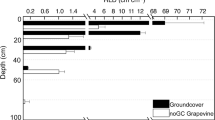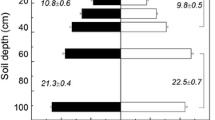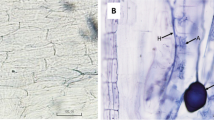Abstract
Aims
The objective of this study was to determine if vineyard groundcover management can mitigate negative plant-soil feedback caused by soil borne pathogens through changes in root fungal communities.
Methods
Whole-soil inoculum was collected from a field trial of groundcover identity (exotic grasses, exotic grasses plus legumes, native grasses, and native grasses plus forbs) and irrigation type (drip, sprinkler, and a combination of both) in a modified feedback experiment with grapevine rootstock ‘101–14’ (Vitis riparia x V. rupestris). To see if these groundcovers would differ in their ability to protect vines against negative feedback caused by a soil borne pathogen, we inoculated all pots with the soil-borne root pathogen, Ilyonectria liriodendri (Halleen, Rego & Crous) Chaverri & C. Salgado.
Results
After eight months, vines growing with soil trained by exotic grasses had greater above-ground growth response relative to sterilized control than did vines growing with soil trained by native grasses and forbs. These treatments also resulted in compositionally distinct root fungal communities. The intensity of root colonization by arbuscular mycorrhizal fungi did not differ among ground cover treatments.
Conclusions
Our results show that soil feedback outcomes for grapevines, including negative effects of black foot pathogens such as Ilyonectria liriodendri, could depend on groundcover vegetation management that alters root-associated fungal communities.





Similar content being viewed by others
References
Agustí-Brisach C, Armengol J (2013) Black-foot disease of grapevine: an update on taxonomy, epidemiology and management strategies. Phytopathol Mediterr 52:245–261
Agustí-Brisach C, Gramaje D, Leon M, Garcia-Jimenez J, Armengol J (2011) Evaluation of vineyard weeds as potential hosts of black-foot and petri disease pathogens. Plant Dis 95:803–810
Alaniz S, León M, Vicent A, García-Jiménez J, Abad-Campos P, Armengol J (2007) Characterization of species associated with black foot disease of grapevine in Spain. Plant Dis 91:1187–1193
Altschul SF, Gish W, Miller W, Myers EW, Lipman DJ (1990) Basic local alignment search tool. J Molec Biol 215:403–410
Anderson MJ, Willis TJ (2003) Canonical analysis of principal coordinates: a useful method of constrained ordination for ecology. Ecology 84:511–525
Austin AT, Yahdjian L, Stark JM, Belnap J, Porporato A, Norton U, Ravetta DA, Schaeffer SM (2004) Water pulses and biogeochemical cycles in arid and semiarid ecosystems. Oecologia 141:221–235
Badri DV, Vivanco JM (2009) Regulation and function of root exudates. Plant Cell Environ 32:666–681
Bardgett RD, Shine A (1999) Linkages between plant litter diversity, soil microbial biomass and ecosystem function in temperate grasslands. Soil Biol Biochem 31:317–321
Benitez MS, Taheri WI, Lehman RM (2016) Selection of fungi by candidate cover crops. Appl Soil Ecol 103:72–82
Berg G, Smalla K (2009) Plant species and soil type cooperatively shape the structure and function of microbial communities in the rhizosphere. FEMS Microbiol Ecol 68:1–13
Bever JD (1994) Feedback between plants and their soil communities in an old field community. Ecology 75:1965–1977
Bezemer TM, Lawson CS, Hedlund K, Edwards AR, Brook AJ, Igual JM, Mortimer SR, Van der Putten WH (2006) Plant species and functional group effects on abiotic and microbial soil properties and plant-soil feedback responses in two grasslands. J Ecol 94:893–904
Broeckling CD, Broz AK, Bergelson J, Manter DK, Vivanco JM (2008) Root exudates regulate soil fungal community composition and diversity. Appl Environ Microbiol 74:738–744
Cameron DD, Neal AL, van Wees SCM, Ton J (2013) Mycorrhiza-induced resistance: more than the sum of its parts? Trends Plant Sci 18:539–545
Carlsson G, Huss-Danell K (2003) Nitrogen fixation in perennial forage legumes in the field. Plant Soil 253:353–372
Casieri L, Hofstetter V, Viret O, Gindro K (2009) Fungal communities living in the wood of different cultivars of young Vitis vinifera plants. Phytopathol Mediterr 48:73–83
De Caceres M, Legendre P (2009) Associations between species and groups of sites: indices and statistical inference. Ecology 90:3566–3574
Druzhinina IS, Kopchinskiy AG, Komon M, Bissett J, Szakacs G, Kubicek CP (2005) An oligonucleotide barcode for species identification in Trichoderma and Hypocrea. Fungal Genet Biol 42:813–828
Eilers EJ, Klein AM (2009) Landscape context and management effects on an important insect pest and its natural enemies in almond. Biol Control 51:388–394
Fanin N, Haettenschwiler S, Fromin N (2014) Litter fingerprint on microbial biomass, activity, and community structure in the underlying soil. Plant Soil 379:79–91
Fourie P, Halleen F, van der Vyver J, Schreuder W (2001) Effect of Trichoderma treatments on the occurrence of decline pathogens in the roots and rootstocks of nursery grapevines. Phytopathol Mediterr 40:S473–S478
Gonzalez V, Luisa Tello M (2011) The endophytic mycota associated with Vitis vinifera in central Spain. Fungal Divers 47:29–42
Gramaje D, Armengol J (2011) Fungal trunk pathogens in the grapevine propagation process: potential inoculum sources, detection, identification, and management strategies. Plant Dis 95:1040–1055
Grayston SJ, Wang SQ, Campbell CD, Edwards AC (1998) Selective influence of plant species on microbial diversity in the rhizosphere. Soil Biol Biochem 30:369–378
Halleen F, Crous PW, Petrini O (2003) Fungi associated with healthy grapevine cuttings in nurseries, with special reference to pathogens involved in the decline of young vines. Australas Plant Pathol 32:47–52
Hamel C, Vujanovic V, Jeannotte R, Nakano-Hylander A, St-Arnaud M (2005) Negative feedback on a perennial crop: Fusarium crown and root rot of asparagus is related to changes in soil microbial community structure. Plant Soil 268:75–87
Harman GE, Howell CR, Viterbo A, Chet I, Lorito M (2004) Trichoderma species - opportunistic, avirulent plant symbionts. Nat Rev Microbiol 2:43–56
Hartwig NL, Ammon HU (2002) Cover crops and living mulches. Weed Sci 50:688–699
Hoeksema JD, Chaudhary VB, Gehring CA, Johnson NC, Karst J, Koide RT, Pringle A, Zabinski C, Bever JD, Moore JC, Wilson GWT, Klironomos JN, Umbanhowar J (2010) A meta-analysis of context-dependency in plant response to inoculation with mycorrhizal fungi. Ecol Lett 13:394–407
Hossain MM, Sultana F, Kubota M, Koyarna H, Hyakumachi M (2007) The plant growth-promoting fungus Penicillium simplicissimum GP17-2 induces resistance in Arabidopsis thaliana by activation of multiple defense signals. Plant Cell Physiol 48:1724–1736
Inglis GD, Kawchuk LM (2002) Comparative degradation of oomycete, ascomycete, and basidiomycete cell walls by mycoparasitic and biocontrol fungi. Can J Microbiol 48:60–70
Johnson NC, Graham JH, Smith FA (1997) Functioning of mycorrhizal associations along the mutualism-parasitism continuum. New Phytol 135:575–586
Karlsson M, Durling MB, Choi J, Kosawang C, Lackner G, Tzelepis GD, Nygren K, Dubey MK, Kamou N, Levasseur A, Zapparata A, Wang JH, Amby DB, Jensen B, Sarrocco S, Panteris E, Lagopodi AL, Poggeler S, Vannacci G, Collinge DB, Hoffmeister D, Henrissat B, Lee YH, Jensen DF (2015) Insights on the evolution of mycoparasitism from the genome of Clonostachys rosea. Genome Biol Evol 7:465–480
Koljalg U, Nilsson RH, Abarenkov K, Tedersoo L, Taylor AFS, Bahram M, Bates ST, Bruns TD, Bengtsson-Palme J, Callaghan TM, Douglas B, Drenkhan T, Eberhardt U, Duenas M, Grebenc T, Griffith GW, Hartmann M, Kirk PM, Kohout P, Larsson E, Lindahl BD, Luecking R, Martin MP, Matheny PB, Nguyen NH, Niskanen T, Oja J, Peay KG, Peintner U, Peterson M, Poldmaa K, Saag L, Saar I, Schuessler A, Scott JA, Senes C, Smith ME, Suija A, Taylor DL, Telleria MT, Weiss M, Larsson KH (2013) Towards a unified paradigm for sequence-based identification of fungi. Molec. Ecol 22:5271–5277
Kurtzman CP, Robnett CJ (1998) Identification and phylogeny of ascomycetous yeasts from analysis of nuclear large subunit (26S) ribosomal DNA partial sequences. Antonie Van Leeuwenhoek Int J Gen Molec Microbiol 73:331–371
Lange M, Habekost M, Eisenhauer N, Roscher C, Bessler H, Engels C, Oelmann Y, Scheu S, Wilcke W, Schulze E-D, Gleixner G (2014) Biotic and abiotic properties mediating plant diversity effects on soil microbial communities in an experimental grassland. PLoS One 9:e96182. https://doi.org/10.1371/journal.pone.0096182
Latz E, Eisenhauer N, Rall BC, Allan E, Roscher C, Scheu S, Jousset A (2012) Plant diversity improves protection against soil-borne pathogens by fostering antagonistic bacterial communities. J Ecol 100:597–604
Maron JL, Marler M, Klironomos JN, Cleveland CC (2011) Soil fungal pathogens and the relationship between plant diversity and productivity. Ecol Lett 14:36–41
McGonigle TP, Miller MH (2000) The inconsistent effect of soil disturbance on colonization of roots by arbuscular mycorrhizal fungi: a test of the inoculum density hypothesis. Appl Ecol 14:147–155
McGonigle TP, Miller MH, Evans DG, Fairchild GL, Swan JA (1990) A new method which gives objective measure of colonization of roots by vesicular arbuscular mycorrhizal fungi. New Phytol 115:495–501
Mueller A, Ngwene B, Peiter E, George E (2017) Quantity and distribution of arbuscular mycorrhizal fungal storage organs within dead roots. Mycorrhiza 27:201–210
Nakagawa S, Schielzeth H (2013) A general and simple method for obtaining R2 from generalized linear mixed-effects models. Methods Ecol Evol 4:133–142
Nicol RW, Yousef L, Traquair JA, Bernards MA (2003) Ginsenosides stimulate the growth of soilborne pathogens of American ginseng. Phytochemistry 64:257–264
Oksanen J et al (2016) Vegan: community ecology package. R package version 2:4–1 https://CRAN.R-project.org/package=vegan
Palmborg C, Scherer-Lorenzen M, Jumpponen A, Carlsson G, Huss-Danell K, Hogberg P (2005) Inorganic soil nitrogen under grassland plant communities of different species composition and diversity. Oikos 110:271–282
Pozo MJ, Verhage A, García-Andrade J, García JM, Azcón-Aguilar C (2009) Priming plant defence against pathogens by arbuscular mycorrhizal fungi. In: Azcón-Aguilar C, Barea JM, Gianinazzi S, Gianinazzi-Pearson V (eds) Mycorrhizas—functional processes and ecological impact. Springer, Berlin, pp 123–135
R Core Team (2016) R: A language and environment for statistical computing. R Foundation for Statistical Computing, Vienna
Rovira AD (1969) Plant root exudates. Bot Rev 35:35–53
Rúa MA, Antoninka A, Antunes PM, Chaudhary VB, Gehring C, Lamit LJ, Piculell BJ, Bever JD, Zabinski C, Meadow JF, Lajeunesse MJ, Milligan BG, Karst J, Hoeksema JD (2016) Home-field advantage? Evidence of local adaptation among plants, soil, and arbuscular mycorrhizal fungi through meta-analysis. BMC Evol Biol 16:122. https://doi.org/10.1186/s12862-016-0698-9
Schreiner RP, Koide RT (1993) Mustards, mustard oils, and mycorrhizas. New Phytol 123:107–113
Simon S, Bouvier JC, Debras JF, Sauphanor B (2010) Biodiversity and pest management in orchard systems. A review. Agron Sustain Dev 30:139–152
Smith SE, Read DJ (2008) Mycorrhizal symbiosis. Academic, New York
Stephan A, Meyer AH, Schmid B (2000) Plant diversity affects culturable soil bacteria in experimental grassland communities. J Ecol 88:988–998
Tabarant P, Villenave C, Risede JM, Roger-Estrade J, Dorel M (2011) Effects of organic amendments on plant-parasitic nematode populations, root damage, and banana plant growth. Biol Fertil Soil 47:341–347
Tukey JW (1949) Comparing individual means in the analysis of variance. Biometrics 5:99–114
Úrbez-Torres JR, Haag P, Bowen P, O'Gorman DT (2014) Grapevine trunk diseases in British Columbia: incidence and characterization of the fungal pathogens associated with black foot disease of grapevine. Plant Dis 98:456–468
Úrbez-Torres JR, Haag P, Bowen P, Lowery T, O'Gorman DT (2015) Development of a DNA macroarray for the detection and identification of fungal pathogens causing decline of young grapevines. Phytopathology 105:1373–1388
Vermeire M-L, Kablan L, Dorel M, Delvaux B, Risede J-M, Legreve A (2011) Protective role of silicon in the banana-Cylindrocladium spathiphylli pathosystem. Eur J Plant Pathol 131:621–630
Vierheilig H, Coughlan AP, Wyss U, Piche Y (1998) Ink and vinegar, a simple staining technique for arbuscular-mycorrhizal fungi. Appl Environ Microbiol 64:5004–5007
Vinale F, Sivasithamparam K, Ghisalberti EL, Marra R, Woo SL, Lorito M (2008) Trichoderma-plant-pathogen interactions. Soil Biol Biochem 40:1–10
Vukicevich E, Lowery T, Bowen P, Urbez-Torres JR, Hart M (2016) Cover crops to increase soil microbial diversity and mitigate decline in perennial agriculture. A review Agron Sust Develop 36
Waldrop MP, Zak DR, Blackwood CB, Curtis CD, Tilman D (2006) Resource availability controls fungal diversity across a plant diversity gradient. Ecol Lett 9:1127–1135
Whipps JM (2004) Prospects and limitations for mycorrhizas in biocontrol of root pathogens. Can J Bot 82:1198–1227
White TJ, Burns T, Lee S, Taylor J (1990) Amplification and sequencing of fungal ribosomal RNA genes for phylogenetics. In: Innis MA, Gelfand DH, Sninsky JJ, White TJ (eds) PCR protocols a guide to methods and applications. Academic Press, San Diego, pp 315–322
Whitelaw-Weckert MA, Rahman L, Hutton RJ, Coombes N (2007a) Permanent swards increase soil microbial counts in two Australian vineyards. Appl Soil Ecol 36:224–232
Whitelaw-Weckert MA, Nair NG, Lamont R, Alonso M, Priest MJ, Huang R (2007b) Root infection of Vitis Vinifera by Cylindrocarpon liriodendri in Australia. Australas Plant Pathol 36:403–406
Whitelaw-Weckert MA, Rahman L, Appleby LM, Hall A, Clark AC, Waite H, Hardie WJ (2013) Co-infection by Botryosphaeriaceae and Ilyonectria Spp. Fungi during propagation causes decline of young grafted grapevines. Plant Pathol 62:1226–1237
Wright AJ, Wardle DA, Callaway R, Gaxiola A (2017) The overlooked role of facilitation in biodiversity experiments. Trend Ecol Evol 32:383–390
Yang H, Zang Y, Yuan Y, Tang J, Chen X (2012) Selectivity by host plants affects the distribution of arbuscular mycorrhizal fungi: evidence from ITS rDNA sequence metadata. BMC Evol Biol 12:50. https://doi.org/10.1186/1471-2148-12-50
Acknowledgements
This paper is dedicated to the memory of Diana Morales, who greatly enhanced both the content and enjoyment of this work. The authors also wish to acknowledge the funding sources that made this work possible. EV was supported by the British Columbia Wine Grape Council and the Growing Forward 2 program of Agriculture and Agri-Food Canada. MH was supported by the Organic Science Cluster/Growing Forward 2 program of Agriculture and Agri-Food Canada.
Author information
Authors and Affiliations
Corresponding author
Ethics declarations
Conflict of interest
The authors declare that they have no conflicts of interest.
Additional information
Responsible Editor: Philippe Hinsinger
Electronic supplementary material
ESM 1
(DOCX 487 kb)
Rights and permissions
About this article
Cite this article
Vukicevich, E., Thomas Lowery, D., Úrbez-Torres, J.R. et al. Groundcover management changes grapevine root fungal communities and plant-soil feedback. Plant Soil 424, 419–433 (2018). https://doi.org/10.1007/s11104-017-3532-2
Received:
Accepted:
Published:
Issue Date:
DOI: https://doi.org/10.1007/s11104-017-3532-2




